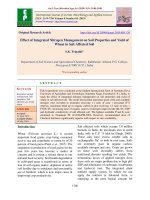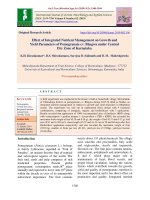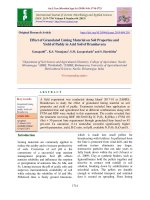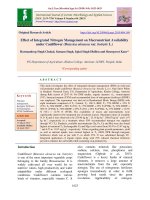Residual effect of integrated nutrient management on soil properties pH, EC, OC and CaCO3
Bạn đang xem bản rút gọn của tài liệu. Xem và tải ngay bản đầy đủ của tài liệu tại đây (155.75 KB, 5 trang )
Int.J.Curr.Microbiol.App.Sci (2020) 9(11): 1615-1619
International Journal of Current Microbiology and Applied Sciences
ISSN: 2319-7706 Volume 9 Number 11 (2020)
Journal homepage:
Original Research Article
/>
Residual Effect of Integrated Nutrient Management on
Soil Properties pH, EC, OC and CaCO3
Ghodke Pallavi Dipak1* and Takankhar Vilas Govindrao2
1
Department of Soil Science and Agriculture Chemistry, Jaywantrao Bhosale Krishna College
of Agriculture, Rethare Bk, (Affiliated to Mahatma Phule Krishi Vidyapeeth, Rahuri) Tal.
Karad District, Satara 415108 Maharashtra, India
2
Department of Soil Science and Agriculture Chemistry College of Agriculture, Latur, Distict,
Latur Vasantrao Naik Marathwada Agricultural University, Parbhani Maharashtra, India
*Corresponding author
ABSTRACT
Keywords
pH, Electrical
conductivity,
Organic carbon,
Calcium carbonate
and Percent
Article Info
Accepted:
12 October 2020
Available Online:
10 November 2020
A field experiment was conducted during Kharif season of 2008-2009 on typic haplustert
at the research farm of Department of soil science and Agricultural Chemistry, College of
Agriculture, Latur. The recommended variety MAUS-71 of soybean was used for this
experiment. The experiment was conducted in RBD comprising three replications and nine
treatments viz. T1(100%RDF), T2(100%RDF+10 t FYM ha-1), T3(50%RDF + 10 t FYM
ha-1 +Biofertilizer), T4(100% RDF + 10 t FYM ha-1 +Biofertilizer), T5(100%RDF + 45Kg
ha-1), T6(50%RDF + 10t FYM ha-1 + 45kg S ha-1), T7(100%RDF + 45kg S ha-1 +
Biofertilizer), T8(50% RDF+10 t FYM ha-1 + 45kg S ha-1 + Biofertilizer), T9(100%RDF +
10 t FYM ha-1 +45kg S ha-1 + Biofertilizer). Chemical properties viz. soil pH, EC and
CaCo3 content in soil were not affected due to different treatments but organic carbon
content in the soil was affected due to combined application of chemical fertilizers along
with enough bulk of farm yard manure containing treatments. Highest organic carbon
(1.38%) was recorded due to use of 100% RDF +10 t FYM ha -1 + 45 kg S ha-1 +
Biofertilizer (T9) treatment followed by 50% RDF +10 t FYM ha -1 + 45 kg S ha-1 +
Biofertilizer (T8). Organic carbon content in soil samples collected after harvest of the
crop was increased in all the treatments over initial (0.31%) soil sample due to residual
effect of soybean crop grown under INM treatment.
Introduction
Soybean (Glycine max L. merill) often
designated as ‘Golden Bean’ is basically a
pulse crop and gained the importance as an
oilseed crop as it contains 20% cholesterol
free oil. It is a legume crop belonging to
family
leguminaceae
and
subfamily
papilionaceae. Being a legume plant, soybean
has ability to fix atmospheric nitrogen with
the help of bacteria and to add organic matter
in the soil, thereby increasing the productivity
of soil.
India ranks fifth in area and production of
soybean in the World. The total production in
1615
Int.J.Curr.Microbiol.App.Sci (2020) 9(11): 1615-1619
India was 108.02 lakh MT on an area of 9.62
million hectares with productivity of 1124 kg
ha-1. In Maharashtra soybean production
during 2008-2009 was 36.50 lakh MT on area
of 30.70 lakh ha with productivity of 1189 kg
ha1.Average consumption in India is 4812
TMT giving the sixth rank in largest
consumer of soybean in World, (Anonymous,
2008).
Efficient management of organic and
inorganic sources is a prerequisite for
achieving continuous productivity of cops in
an economically and ecologically sustainable
manner. Organic matter forms a very
important source of plant nutrients. Chemical
fertilizers are commonly used for supply of
major nutrients, whereas organic manures are
used to supply both macro and micronutrients
and sustain amount of humic substances
particularly humic acid and fulvic acid that
helps to maintain soil pH.
Thus for maintenance of the soil fertility,
productivity and soil health with the FYM,
compost and other organic sources are
gaining importance. Biofertilizers cannot
replace chemical fertilizers, but certainly are
capable of reducing their input. Seed
inoculation with effective Rhizobium
inoculants is recommended to ensure
adequate. Nodulation and N2 fixation for
maximum growth and yield of pulse crop.
Materials and Methods
The field experiment was conducted at
Research farm, Department of soil science
and Agril. Chemistry, College of Agriculture,
Latur during Kharif season of 2008-2009
using soybean (MAUS-71).Soil reaction and
electrical conductivity was determined in
1:2.5 soil:water suspension using digital pH
meter (Jackson,1967) and conductivity bridge
(Jackson,1967)
respectively.
Modified
method of Walkley and Black as described by
Piper (1934) was used for the estimation of
organic carbon from soil. Calcium carbonate
was determined by Rapid titration method
(Puri, 1949). The experiment was conducted
in RBD comprising three replications and
nine treatments viz. T1 (100%RDF.),
T2(100%RDF + 10 t FYM ha-1) T3 (50%RDF
+ 10 t FYM ha-1 + Biofertilizer). T 4(100%
RDF + 10 t FYM ha-1 + Biofertilizer).T5
(100%RDF+45Kg S ha-1). T6 (50%RDF + 10t
FYM ha-1 +45kg S ha-1) T7 (100%RDF +
45kg s ha-1 + Biofertilizer) T8(50% RDF + 10
t FYM ha-1 +45kg S ha-1 + Biofertilizer) T9
(100%RDF+ 10 t FYM ha-1 + 45kg S ha-1 +
Biofertilizer).
The experimental soil was deep black with
clay in texture, calcareous in nature and
slightly alkaline in reaction. Before sowing
initial soil sample was collected from 0-15 cm
depth covering experimental area which was
analysed for various physico-chemical
properties presented in table 1.
Results and Discussion
Residual Effect of INM on soil chemical
properties
Representative soil samples were collected
from each plot after harvest of soybean crop
to study residual effect of INM on soil
chemical properties. The results regarding soil
pH, EC, organic carbon and CaCO3 are
presented in table 2.
Soil pH
The residual effect of integrated nutrient
management on pH of the soil is presented in
table 1. The results regarding pH of soil was
not affected significantly due to different
treatments. Lower (8.12) and highest (8.23)
pH of soil was recorded with the treatment T8
(50% RDF + 10 t FYM ha-1 +45 kg S ha-1 +
Biofertilizer) and T1 (control) respectively.
1616
Int.J.Curr.Microbiol.App.Sci (2020) 9(11): 1615-1619
The data further revealed that the pH of soil
was decreased than the initial pH of soil
(8.40).
This decrease in pH might be due to the
continuous use of urea-N, Which initiated to
acid forming reactions in the soils. A decrease
in pH of soil under farmyard manure
treatments may be due to deactivation of Al3+
and concomitant release of basic cation upto
its decomposition, Mann et al., (2006) and
Swarup and Ghosh(1979).
Laxminarayana and Patiram (2005) showed
that the pH of the soil decreased slightly with
the addition of organic manures over the
initial value, that might be attributed to the
formation
of
organic
acids
during
decomposition of organic matter.
Soil EC
The data presented in table 2 indicated that
the difference in soil EC values due to
different treatments were not reach to the
level of significance. Minimum (0.123 dsm-1)
and maximum (0.138 dsm-1). EC values were
recorded due to T1 (control) and T9 (100%
RDF + 10 t FYM ha-1 +45 kg S ha-1 +
Biofertilizer) respectively. The data regarding
residual effect of INM on soil EC further
reveals that the EC (0.160 dsm-1) of initial soil
sample was higher as compared to the
samples collected after harvest of the crop.
This decrease in EC of post harvest soil
sample might be due to leaching of salts due
to rains and utilization of nutrients by the
crop. Similar results were also observed to
Mann et al (2006).
Table.1 Physico-chemical properties of soil as influenced by INM
Sr. No.
A)
1
2
3
4
5
6
7
8
B)
1
2
3
4
5
6
7
8
Soil parameters
Physical parameters
Coarse sand
Fine sand
Silt
Clay
Textural class
Bulk density
Particle density
Porosity
Fertility parameters
Ph
EC
Organic carbon
CaCO3
Available nitrogen
Available phosphorus
Available potassium
Available sulphur
1617
Estimate and units
15.10
17.90
23.55
43.45
Clayey
1.29
2.44
48.50
Per cent
Per cent
Per cent
Per cent
Mg m-3
Mg m-3
Per cent
8.40
0.16
0.31
5.00
175.61
22.44
243.15
16.25
dsm-1
Per cent
Per cent
Kg ha-1
Kg ha-1
Kg ha-1
Kg ha-1
Int.J.Curr.Microbiol.App.Sci (2020) 9(11): 1615-1619
Table.2 Chemical properties of soil as influenced by INM
Treatment details
pH
(1:2.5)
8.23
8.19
8.16
T1 (100% RDF)
T2 (100% RDF+10 t FYM ha -1)
T3 (50% RDF +10 t FYM ha -1
+Biofertilizer)
T4 (100% RDF+10 t FYM ha -1
+Biofertilizer)
T5 (100% RDF+45 Kg S ha -1)
T6 (50% RDF+10 t FYM ha -1 +45
kg S ha -1)
T7 (100% RDF+45 kg S ha -1
+Biofertilizer)
T8 (50% RDF+10 t FYM ha -1 +45
kg S ha -1 + Biofertilizer)
T9 (100 % RDF+10 t FYM ha -1 +45
kg S ha -1 + Biofertilizer)
Initial
S.E.+
CD at 5%
Organic carbon
The results regarding residual effect of
integrated nutrient management on organic
carbon are presented in table 2. It is evident
from the results that the organic carbon
content in soil was increased significantly due
to treatment T9 (100% RDF + 10 t FYM ha -1
+45 kg S ha -1 + Biofertilizer). The treatment
T9 (1.38 %) was significantly superior over
rest of the treatments. Lower organic carbon
(0.78%) content was recorded due to
treatment T1 (Control). Further, it was
observed from the data that the organic
carbon in soil was increased in soil samples
collected after harvest of soybean crop as
compared to initial soil samples (0.31 %).
This increase in organic carbon over initial
soil samples might be due to residual effect of
soybean crop which might be responsible for
addition of organic residues in soil. Another
reason for this might be the application of
EC(dsm-1)
(1:2.5)
0.123
0.132
0.129
OC (%)
CaCo3 (%)
0.78
1.11
0.89
4.95
4.62
4.51
8.22
0.134
1.19
4.68
8.15
8.18
0.125
0.131
0.80
0.98
4.78
4.47
8.14
0.127
0.84
4.84
8.12
0.136
1.25
4.15
8.20
0.138
1.38
4.31
8.40
0.08
NS
0.160
0.005
NS
0.31
0.01
0.03
5.0
0.39
NS
FYM in soil which increases the organic
carbon content in soil. These results are in
confirmity with the results of Jenkinson and
Johnston(1977). They reported that farm yard
manure increased organic carbon directly and
also by improving crop yields, resulting in
increased left over of root and plant biomass
in the soil.
Calcium carbonate
The results regarding residual effect of INM
on calcium carbonate content in soil after
harvest of soybean crop indicated in table 2
revealed that there was no significant effect
on CaCO3 content of soil due to different
treatments. However, higher (4.95%) calcium
carbonate was recorded with the treatment T1
(control) and lower (4.15%) content of
calcium carbonate content in the post harvest
soil samples than the initial (5%) soil
samples. It indicates that soybean crop
1618
Int.J.Curr.Microbiol.App.Sci (2020) 9(11): 1615-1619
decreases the calcium carbonate content in the
soil because of addition of sufficient organic
matter in soil.
References
Anonymous (2008). Stage wise area and
production of oilseeds in India w.w.w.
India Agronet.com
Jackson, M.L. (1967).Soil chemical analysis.
Prentice Hall of India. Pvt. Ltd., New
Delhi. pp 128,152 and 283.
Jenkinson, D.S. and Johnson, A. E.(1977).
Soil organic matter in the Hoosefield
continuous
barley
experiment.
Rothamsted
Experiment
Station,
Annual Report 1976, Part II, PP 87101.
Laxminarayana, K. and Patiram, (2005).
Influence of inorganic, biological and
organic manures on yield and nutrient
uptake
of
groundnut
(Arachis
hypogaea) and soil
properties.
Indian j. Agric. Sci. 75(4):218-221.
Mann, K.K., Brar, B.S. and Dhillon,
N.S.(2006). Influence of long term use
of farmyard manure and inorganic
fertilizers on nutrient availability in a
Typic Ustrochrept Indian J. Agric. Sci.,
45(2): 288-292.
Piper, C.S. (1934). Soil and plant analysis.
Hans Publications Bombay. pp. 368.
Puri, A.H. (1949). Soil, their physics and
chemistry, Reinhold Publ. Corporation
New York U.S.A.
Swarup and Ghosh A.B.(1979). Effect of
intensive cropping and manuring on
soil properties and crop yields. Indian
J.Agric.Sci., 49:938-944.
How to cite this article:
Ghodke Pallavi Dipak and Takankhar Vilas Govindrao. 2020. Residual Effect of Integrated
Nutrient
Management
on
Soil
Properties
pH,
EC,
OC
and
CaCO3.
Int.J.Curr.Microbiol.App.Sci. 9(11): 1615-1619. doi: />
1619







![Effect of integrated nutrient management and bio-regulators on quality attributes of sprouting broccoli [Brassica oleracea (L.) Var. Italica Plenck] effect of Integrated Nutrient Management](https://media.store123doc.com/images/document/2020_01/14/medium_ldn1578943904.jpg)

